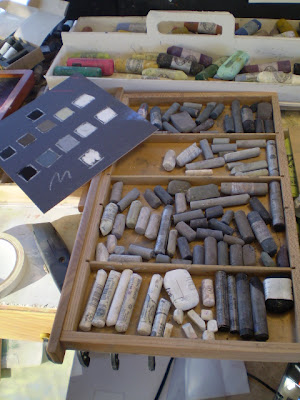1. Use a set of gray, harder pastels organized like this: five values of warm gray and five values of cool gray. Lay in your drawing with vine charcoal, or some other dark tool, and then create the whole painting in just gray. Register the grays on a separate piece of the same paper you are using. Now, add in your colors, but be sure to match the values against your gray scale register.
2. I do keep my grays separated in many ways, as I touched on last week. My hard gray sticks are in their own section among the hard pastel sets. Then, I take my truest grays and keep them in a separate storage box, but divided into sections by temperature, and from dark to light in each section. Of course, you'll want to organize your black and white sticks somehow. I suggest you separate them from the grays to give yourself an organized and easy way to reach for the grays!
3. Further, I keep my colored grays in with the big palette tray - most notably the almost white tinted grays. Many manufacturers are offering sets of grays, now. I highly recommend these if you are building your palette, but don't forget to buy some true grays and not just the tinted ones.
2. I do keep my grays separated in many ways, as I touched on last week. My hard gray sticks are in their own section among the hard pastel sets. Then, I take my truest grays and keep them in a separate storage box, but divided into sections by temperature, and from dark to light in each section. Of course, you'll want to organize your black and white sticks somehow. I suggest you separate them from the grays to give yourself an organized and easy way to reach for the grays!
3. Further, I keep my colored grays in with the big palette tray - most notably the almost white tinted grays. Many manufacturers are offering sets of grays, now. I highly recommend these if you are building your palette, but don't forget to buy some true grays and not just the tinted ones.
 Near Section - Blacks and Whites; Next - Warm Grays, by Value; Lastly - Cool Grays in Two Sections, by Value
Near Section - Blacks and Whites; Next - Warm Grays, by Value; Lastly - Cool Grays in Two Sections, by Value4. Consider two types of thumbnail sketches in starting a work. One is just values, done in black and white. I often use a big, dull woodless graphite pencil for this on white sketch paper. The other is a color composition, where I try to work out most of the color ideas before hand. If I am being experimental, I may do a large sketch for colors, and just let myself go.
5. Do a gradient sky sometime using ultramarine, but actually mix the dark side with black! Try it with the black over the blue, just the opposite of the typical rules. You may be excited at the depth of sky you achieve.




























